‘You would have to be absolutely batty to miss this rare chance to be among the few people in the world to see this movie!’ proclaimed the promo for a secret screening of ‘An Untitled and Perfectly Legal Coming-of-Age Parody Film’.
Directed by Vera Drew, ‘Untitled and Perfectly Legal’ is the autobiographical story of a young trans woman navigating the aggressively male world of alternative comedy during her transition. It’s often very funny—early jokes accompany praise of successful male comedians with ‘before the unpleasantness’— but it’s also emotional, at times heartbreaking. Vera’s deadname is bleeped out each time it’s spoken, and her relationships with her mother and boyfriend are rollercoaster rides that are all sharp turns.
Made during Covid, the film is visually like nothing else. Drew called on her collaborators in TV comedy to enlist animators from around the world, each adding their own sequences to the live action, creating a mash-up of a dozen different styles on screen. It feels like someone is riffling a zine in front of your eyes. Purples and greens bleed like battery acid.
But there’s something else noteworthy about ‘Untitled and Perfectly Legal’, and it is hinted at in the dedication to ‘Mom’ and ‘Joel Schumacher’. The film is actually entitled The People’s Joker, and is an unauthorised Batman parody.
At least, the filmmaker is quite sure it’s a parody, and should therefore be covered under the doctrine of fair use.
Warner Brothers’ lawyers, unfortunately, disagree.
In The People’s Joker, the protagonist becomes Joker the Harlequin, a wannabe comic at the only ‘authorised’ comedy show in Gotham City. Batman’s drones patrol the city to ensure all jokes are appropriate. Joker’s best friend is the Penguin. Her psychiatrist is the Scarecrow. While it draws on all eras of Batman stories, the film’s primary inspiration is Todd Phillips’ Joker (2019)—down to a show-stopping parody of Joaquin Phoenix’s infamous stair-dance, set to a riff on Prince’s Partyman from Batman (1989).
After its single screening at the Toronto International Film Festival in 2022, The People’s Joker seemed destined to be what Variety called an ‘attention-grabbing calling-card’, vanishing from popular culture much like Todd Haynes’ Superstar: The Karen Carpenter Story (1987), which was famously sued out of circulation.
I would argue, however, that this case is different. The People’s Joker is a superhero story, and superhero stories have always had a complicated relationship to what counts as ‘official’.
Batman has met Sherlock Holmes, the X-Men have fought Dracula, Superman knows Robin Hood, and the Fantastic Four have encountered the Dashwood sisters from Sense and Sensibility. There’s even a Norse god in the Avengers! Marvel and DC Comics have never been shy about pillaging the public domain for their own benefit.
The regular claims that superhero stories are a kind of ‘modern mythology’ almost never account for the fact that these are corporate-owned characters, fiercely protected. In 2014, DC Entertainment refused at first to let the Superman logo be used on the gravestone of a murdered five-year-old boy. The American Bar Association wrote that DC’s ‘aggressive policing’ echoes Batman’s own crime-fighting, and that ‘no one is immune, even deceased children.’
It’s true that, in his own universe, Batman is extremely protective of his brand and who gets to wear it, to the point of quipping in a recent issue ‘Should I call the battorney?’ after seeing an unlicensed product. As scholar Will Brooker points out, ‘as owner of Wayne Enterprises, [Batman] fully understands the power of branding. [The bat-logo] carries an unchanging set of meanings across a range of diverse creative interpretations.’
Batman can be grim and violent, bright and cheerful, liberal or conservative—any of thousands of interpretations of the character over the decades—and still be Batman. The only thing he can’t be is in a story told by someone other than DC Comics and Warner Brothers.
On the other hand, The People’s Joker, fittingly, embraces what media theorist Jim Collins describes as the Joker’s ‘hijacking of signs’. Writing about the 1989 Batman movie, Collins says that while Batman recalls and retrieves the past through media, the Joker cuts up and manipulates the images around him: ‘This tension between abduction and retrieval epitomizes the conflicting strategies at work in this film.’
The People’s Joker pushes that ‘abduction’ to the limit. It takes Batman’s brand and runs with it, giggling maniacally. In the post-screening Q&A, Drew agreed with the idea that to be trans—especially right now, when many feel just fine about saying you should be wiped off the face of the earth—is to be ‘Joker-pilled’. It is to be forced to embrace the comedy and chaos of your life. What could be more perfect than refiguring the Joker’s fall into a vat of toxic chemicals into a vat of oestrogen instead?
Corporations like DC and Warner, or Marvel and Disney, want you to be a fan of the company first, the characters second, and actual creators a distant third. One of the most enjoyable elements of The People’s Joker is that you can see the fingerprints of the many hands that made it. It’s a refreshing change from most superhero blockbusters, which seem to exist as factory products, each entry there to justify the next, reeking of studio notes. If they didn’t need celebrities to promote their films, I’m convinced these companies would like to make you forget the performers themselves exist, let alone writers and directors.
It’s working, too. When actor Jonathan Majors was recently arrested for assault, the online discourse wasn’t focused on his alleged crimes. According to Shamira Ibrahim at Refinery29, it was ‘conjectures over whether his nascent role as Kang the Conqueror in the Marvel franchise would be protected [that] dominated the conversation.’ Marvel was what mattered; everything human paled in comparison to its monolithic brand.
Disney is finally about to lose the copyright to the very first Mickey Mouse cartoon, Steamboat Willie (1928), after successfully fighting for a number of extensions that caused the terms of copyright law to be rewritten. The company will retain the trademark, meaning that you can’t tell a Mickey Mouse story that could be confused as coming from Disney itself. No-one would mistake The People’s Joker as being an official DC production—but if Disney fought for Mickey for decades, one can only imagine the future battles over the Dark Knight.
Perhaps one day the character will join the likes of Sherlock Holmes, Robin Hood or Hercules, and the Joker, too, really will belong to the people. Until then, corporate franchises can only be a poor substitute for a true mythology. I hope that more people get to see The People’s Joker soon, battorneys be damned.



